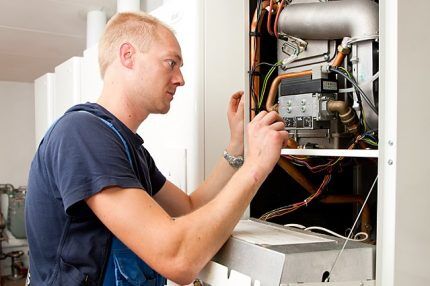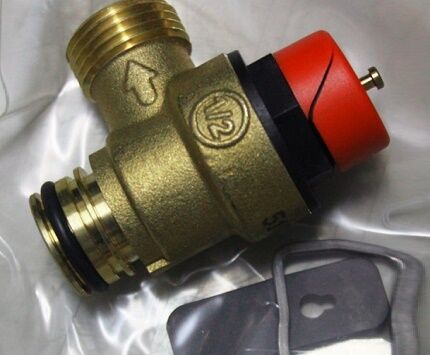Gas boiler valve repair: how to repair the unit by correcting characteristic malfunctions
Gas boilers are reliable equipment that supply our country houses and some city apartments with heat and hot water. Unfortunately, they cannot work completely without breakdowns. And violations often include valves—devices for protecting and supplying fuel to units.
We will tell you how and what kind of gas boiler valve repairs you can do yourself. We will analyze in detail the situations that signal the occurrence of related disruptions in work. We’ll tell you whether it’s worth making your own efforts or whether it’s better to turn to gas workers.
In our article you will find step-by-step guides to restoring the performance of gas boilers by repairing or replacing the gas, safety and three-way valves.
The content of the article:
Types of valves in a gas boiler
The normal operation of gas equipment intended for heating sanitary water and preparing coolant is ensured by a wide range of systems, parts, devices, each of which clearly performs the important function assigned to it.
The design of gas boilers has the following types of valves:
- Gas valve. A component of the gas system responsible for the proportional supply of blue fuel to the gas burner, ensuring a stable combustion process in accordance with the commands of the electronic board. This electromagnetic device also includes shut-off and control valves.
- Safety valve. A component of a hydraulic system designed to discharge excess coolant from the heating circuit if the standard pressure values are exceeded.
- Three way valve. Part of the hydraulic system of double-circuit boilers only. Redirects the flow of heated water from the heating circuit to the hot water supply during its consumption for hygienic purposes. Depending on the class of the boiler, it can be with or without a servo drive.
All of the listed types of valves involved in the operation of a gas boiler can be replaced or repaired in the event of a breakdown.
Let's take a look at the technology for restoring their functionality.By mastering simple repair principles and techniques, you can significantly increase the service life of the boiler itself.
Typical breakdowns and repair methods
The types of valves listed above perform ambiguous functions and differ in design. The reasons why they become unusable and the ways to fix the breakdown also differ.
Gas valve malfunctions
The main purpose of the gas valve is to regulate the gas pressure supplied through the nozzles to the burner. The flow can be adjusted so that from 25 to 100% of the flow enters the chamber. It all depends on what type of gas will be used in the operation of the equipment, how much air will be supplied for normal combustion.
In fact, it is an electromagnetic device, the main work of which is carried out only when connected to the power supply. However, when its solenoid coils are de-energized, the gas valve functions as a safety feature. In this case, it tightly blocks the channels through which gaseous fuel moves.

Generated geyser thermocouple or heating boiler, the charge hits the electromagnet (coil) of the gas valve, as a result of which the metal washer of the shut-off valve is magnetized to the coil. The washer opens the membrane so that gas can pass to the igniter and burner block nozzles.
When the flame fades or decreases below standard values, the thermocouple stops generating electricity.As a result, the coil holding the washer is demagnetized. The blue fuel supply channels are closed.

The need to take action will be indicated by a drop or increase in static pressure, i.e. inlet pressure when the boiler is not operating. For units processing main gas, it must be at least 17 mbar. For boilers powered by liquefied fuel - not lower than 35 mbar.
The list of typical gas valve failures includes:
- Disturbances in the electrical circuit supplying the electromagnetic device. In this case, all wiring and contacts in the connection areas should be checked with a multimeter. If a break is detected, it is eliminated in a trivial way: by replacing the damaged wire, stripping and tightening the contacts.
- Gas valve clogged. The channels of the device can periodically become clogged with mineral particles supplied along with low-quality gas, elemental carbon deposits and calcium salts formed when there is condensation in the supplied fuel. Simple mechanical cleaning helps.
- Thermocouple failure. Often requires complete replacement due to complete burnout of the working edge. In this case, no current is transmitted to the electromagnet at all, as a result the boiler does not ignite at all or is blocked after a couple of minutes of operation.
- Mechanical damage to the gas valve. For example, the washer above.It either stops pressing tightly and ensuring a tight seal, or does not respond to adjustment, which is why an uncontrolled volume of gas enters the chamber. To eliminate this, either the valve or the damaged part is replaced.
- Short circuit to the housing of the electromagnetic coil winding. Most often it occurs due to short-term overheating and subsequent melting of the plastic sleeve on which the turns of the electromagnet are wound.
It is clear that the list of all breakdowns can be divided into two groups: violations in the electrical part and mechanical damage to parts.

We immediately warn you that when carrying out any repairs for which it will be necessary to remove the unit body, the owner automatically deprives the owner of the right to take advantage of the manufacturer’s warranty. In addition, neither the company nor the organization with which the agreement is concluded service contract, will not bear the slightest responsibility for a negative result.
It happens that instead of learning how to properly repair the solenoid valve of a gas boiler, the owner of the unit stubbornly tries to turn it on. At the same time, he continuously presses the button on the gas supply device, trying to start the burner. It is absolutely impossible to do this.
If you open the path to the gas flow yourself, the boiler burner will still not light. But the gas will flow uncontrollably into the room as long as the owner literally keeps his finger on the trigger.What is the threat? At best, mild poisoning, at worst, an explosion.
The following selection of photos will familiarize you with the steps to restore the electromagnetic coil of the gas valve:
Repairing a gas boiler valve is not very easy, but it is much cheaper than buying and installing new equipment for preparing coolant and hot water.
After completing the repair, for the purpose of prevention, all components of the gas system should be cleaned of contaminants. Flux should be removed from soldering areas using a solvent intended for this purpose. Next, you need to check the functionality of the valve by powering it from a 1.5V battery.
Safety valve problems
The design of a new generation wall-mounted gas boiler must have at least one safety valve. IN geysers and in old floor heating units it was not provided. It was believed that this protective device should have been mounted on the pipeline after the boiler.
Double-circuit units that process the heating system and sanitary water supply branches can be equipped with a pair of safety valves. One of them is installed for heating, the second for the hot water pipeline. In both cases, this device opens slightly from excess pressure in the system and releases excess water. Then it closes automatically.

Gas boiler owners will be informed of problems with the safety valve by a leak in the area where this safety device is located. It is located at the bottom of the unit, near the circulation pump. The technical data sheet will show you the exact location.
If there is a serious breakdown, there is no point in repairing the safety device.Only replacement is made. If a grain of sand is stuck under a seal or in a mechanical part, there is a reason to simply disassemble and reassemble the device.
Problems with the one-way valve
We repeat - three-way valves are supplied only double-circuit boilers. Their task is to redirect the flow of water from heating to hot water supply and vice versa. More precisely, water, at the command of a three-way tap, enters a plate heat exchanger for subsequent supply to water collection points or to the main heat exchanger connected to the heating system.
Malfunctions in the operation of the three-way valve can be determined:
- By reducing the temperature of the coolant in the heating circuit.
- Through cold water entering plumbing fixtures when heating equipment is operating.
- Due to the absence of a switching effect, i.e. for heating either only coolant or only sanitary water.
The most common cause of failure of a three-way valve is the appearance of mineral deposits on the internal walls of the device. This happens due to a simple blockage, due to the fact that a filter was not installed on the water supply in front of the gas boiler.
The servo drive burns out much less often or its individual components fail. If problems with the drive are detected, the entire three-way valve will have to be replaced. It is selected according to the specifications specified in the technical data sheet by the manufacturer of the unit.
However, there is no need to mercilessly throw away the switching device if it fails to work. You can try to restore the functionality of such a device in order to leave it as a backup device.
The three-way valve repair steps are detailed in the following photo gallery:
Do not forget that the water redirection device is connected to the power supply.This means that if the valve itself is not damaged, the problem may be in the wiring. They can be eliminated in a simple way: first, check the wiring, and then replace the damaged wire.
If everything is in order with the wiring, then you need to check the contacts. All connections are checked with a multimeter. For prevention, they need to be disconnected, wiped with an alcohol-containing composition, and reconnected, tightening with force.
It happens that the failure of a three-way valve to do its job is not the fault of the valve itself or the electrical wiring, but of the electronic board sending the commands. In the workshop, of course, they can restore it and replace the burnt out resistor. But most often they replace it completely with a similar model.
Conclusions and useful video on the topic
The following video will introduce you to the structure of the gas valve, the causes of malfunctions and repair methods:
Solving the problem with the three-way valve of a gas heating unit:
Disassembling and cleaning the safety valve:
Repairing gas equipment valves will significantly extend the operating life of the units. Repairing them is much easier and cheaper than buying a new model. Not all repair operations are recommended to be carried out independently, but the simplest steps are quite accessible to home craftsmen.
Would you like to share your own experience in restoring the functionality of gas boiler valves? Do you have useful information on the topic of the article that is worth sharing with site visitors? Please leave comments in the block below, ask questions, post photos.




YOU write “check the functionality of the valve by connecting a 1.5 V battery. And then what?
You should hear characteristic clicks (without removing the valve) ???? Or how ??